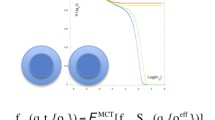Abstract
A new formulation of statistical thermodynamics is derived for classical fluids of molecules that tend to associate into dimers and possibly highers-mers due to highly directional attraction. A breakup of the pair potential into repulsive and highly directionally attractive parts is introduced into the expansion of the logarithm of the grand partition function in fugacity graphs. The bonding by the directional attraction is used to classify the graphs and to introduce a topological reduction which results in the replacement of the fugacity by two variables: singlet densityρ and monomer densityρ 0. Results for the thermodynamic functions as functionals ofρ andρ 0 are given in the form of graph sums. Pair correlations are analyzed in terms of a new matrix analog of the direct correlation function. It is shown that the low-density limit is treated exactly, while major difficulties arise when the Mayer expansion, which employs onlyp, is used. The intricate resummations required for the Mayer expansion are illustrated for the case where dimers are the only association products.
Similar content being viewed by others
References
J. K. Percus and G. J. Yevick,Phys. Rev. 110:1 (1958).
T. Morita and K. Hiroike,Prog. Theor. Phys. 23:1003 (1960).
J. M. van Leeuwen, J. Groeneveld, and J. deBoer,Physica 25:792 (1959).
M. S. Green,J. Chem. Phys. 33:1403 (1960).
E. Meeron,J. Math. Phys. 1:192 (1960).
G. S. Rushbrooke,Physica 26:259 (1960).
L. Verlet,Nuovo Cimento 18:77 (1960).
M. S. Wertheim,Molec. Phys. 26:1425 (1973).
E. L. Pollock, B. J. Alder, and G. N. Patey,Physica 108A:14 (1981).
H. C. Andersen,J. Chem. Phys. 59:4717 (1973).
H. C. Andersen,J. Chem. Phys. 61:4985 (1974).
D. Chandler and L. R. Pratt,J. Chem. Phys. 65:2925 (1976).
G. Stell, inThe Equilibrium Theory of Classical Fluids, H. L. Frisch and J. L. Lebowitz, eds. (Benjamin, New York, 1964), pp. II-171–261.
A. M. Lockett III,J. Chem. Phys. 72:4822 (1980).
J. S. HØye and K. Olaussen,Physica 104A:435 (1980).
P. T. Cummings and G. Stell,Molec. Phys. S1:253 (1984).
Author information
Authors and Affiliations
Additional information
Supported by the NSF under Grant Nos. CHE-81-14968 and CHE-82-11236 and by the U.S. Air Force under Grant No. AFOSR 82-0016A.
Rights and permissions
About this article
Cite this article
Wertheim, M.S. Fluids with highly directional attractive forces. I. Statistical thermodynamics. J Stat Phys 35, 19–34 (1984). https://doi.org/10.1007/BF01017362
Received:
Issue Date:
DOI: https://doi.org/10.1007/BF01017362




